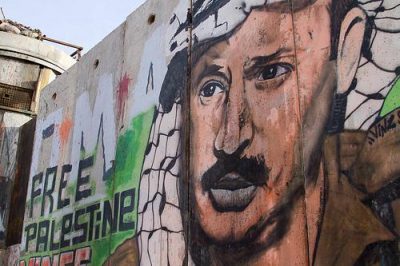This blog is part of a series on the end of the two-state paradigm for Israel and Palestine, which can be read in full on Mondoweiss’ website.

Graffiti on a wall separating Palestine and Israel (Zachary Baumgartner/flickr)
On the ground, in the real world, of course there is no longer any possibility of a real “two-state” solution. Two “real” states would mean that alongside Israel, constituting 78% of historic Palestine, there would be a really independent, actually viable, fully sovereign state of Palestine on the 22% remaining, made up of the Gaza Strip, Arab East Jerusalem, and the entire West Bank.
The claimed permanence and continued expansion of city-sized, Jews-only settlements across East Jerusalem and the West Bank populated by over 600,000 people, the Separation Wall seizing 10% or so of West Bank land and most of its key water sources for Israel and not Palestine, and the unchallenged Israeli determination that any future Palestinian “state” would have no control over its borders, airspace, coastal waters and would be kept forcibly disarmed by outside actors… all make a mockery of “two states.” While the creation of a Palestinian “state,” made up of a bunch of scattered non-contiguous cantons amounting to less than half of the 22% of historic Palestine, is certainly possible, the notion that it would amount to an independent, sovereign, real state is specious; the idea exists today only as a diplomatic fiction.
All of historic Palestine – Israel, the West Bank, Gaza, and East Jerusalem – are currently under the control of one government and one army – Israel’s. (The “Palestinian Authority’s” authority is limited to essentially municipal power.) But the peoples of that land live under very different legal regimes, with different levels of rights, privileges and discrimination facing Jewish citizens of Israel, Palestinian citizens of Israel, Palestinian residents of East Jerusalem, Jewish settlers in the West Bank, and Palestinians living under military occupation in the West Bank and Gaza, as well as Palestinian refugees denied their international right to return to their homes. Today, those separate legal systems, designed to privilege one group – Jews – at the expense of another group – non-Jews, which means Palestinians – stands in violation of the International Covenant for the Prevention and Suppression of the Crime of Apartheid.
Ultimately, the nature of the political solution – one state or two states, secular or bi-national, regionally federated or isolated – is up to the people who live there. A civil rights or anti-apartheid struggle for equality could in theory emerge in either a one or two-state context. (With two states, there would need to be complete equality between the two states as well as within both states.) But for those of us in the U.S. who are not either Palestinians or Israelis, that’s not our call.
For us, the issue should focus on rights, not on political arrangements which are ultimately not our business. Our goal should be to change the policies of our government, whose military aid and unlimited political and diplomatic protection enable Israel’s policies and sustain its power. We should focus on ending the U.S. policy of support for occupation and apartheid, in favor of a policy based on international law, human rights, and equality for all.
Read the original blog on Mondoweiss.
